Media Molecule has been working on the PlayStation 4 game Dreams for an insanely long time. Viewed as a kind of sequel to LittleBigPlanet, it’s a game where players can create their own dreams. They will be able to share their creations with other players, who can take these ideas and build upon them, creating a neverending tree of user-generated content.
It’s a bit like Microsoft’s failed Project Spark, but in this case, players can create their own fundamental building blocks from scratch. Last month, Media Molecule made Dreams available to players via Early Access, allowing them to create their own game worlds and assets. In the meantime, Media Molecule is working on a single-player story to help players walk through the creation process.
I interviewed Abbie Heppe, communications manager at Media Molecule, and John Beech, its principal designer. They walked me through how it’s easy to create characters, landscape, and gameplay with the Dreams editing tools. And as they showed me their own projects, it dawned on me how great a tool this can be for budding artists, game designers, and other creative types.
Here’s an edited transcript of our interview.
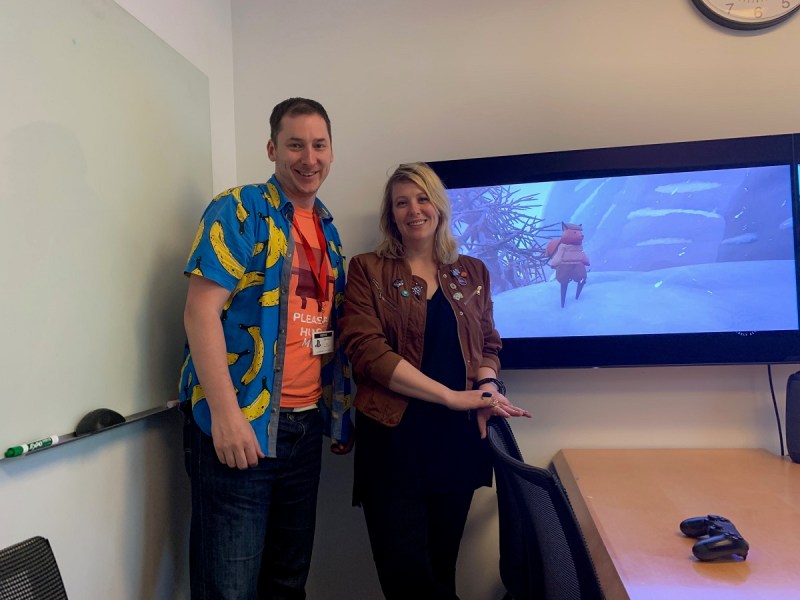
Above: John Beech, principal designer, and Abbie Heppe, communications manager, of Media Molecule.
John Beech: This is where you go to make your dreams. Dream-surfing, where you go check out other people dreams. We have these community jams. We change them up to engage the community. The theme right now is spring, for example. User profiles. We’re going to start by looking at some dreams.
Abbie Heppe: We have this idea of autosurf, which is — if you just want to go in and you don’t know what to play or what to look for, it’ll just take you through a series of dreams. It’s the no-effort version to check out what the community has been making. But if you want to search through here, these are all the games people generally think are finished.
Beech: I set it on recent, so we haven’t seen any of these yet. There’s probably been 20 in the last hour. It’s great seeing all the things people have made. People have made their own UI. It’s pretty cool. On Twitter there’s a hashtag, #madeindreams, and people have been relentlessly sharing stuff.
Heppe: This person has built a full inventory system and dialogue trees for their game. You can check your messages. It’s very cool.
GamesBeat: Can you tell how big some of these are by browsing through?
Heppe: If a user has made their level remixable, which means anybody in the community can take it and make their own version, then you can fly around the map without being in the character and get a sense of the scale of the level. But you can also chain levels together. You can make incredibly big games that go on for — you can make open world games and things like that.
Beech: The breadth of games you can make is insane. You can go from something like that to–this is something someone made in the beta. Bear in mind, it’s only been out a couple of weeks. People have had only so long to get familiar with the tools. That they’ve had the time to produce these kinds of works is just outstanding.
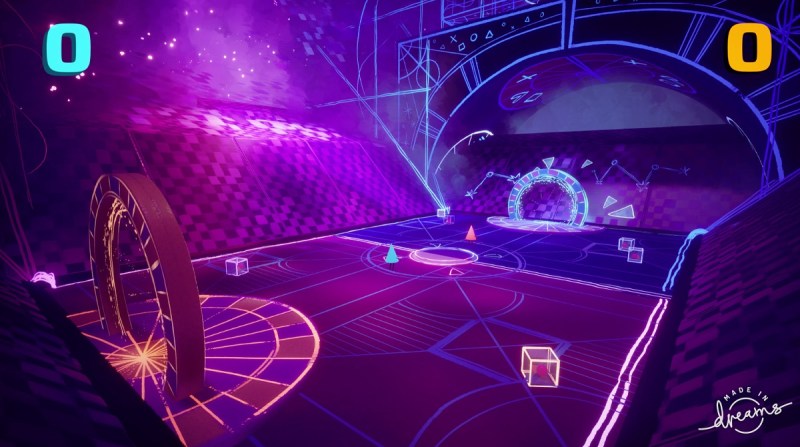
Above: Players can create their own levels in Dreams.
Heppe: If somebody else wanted to make a different hovercraft game, they could take the hovercraft, put it in their level, and build a whole new world for it.
Beech: To go from something like that to where we were before, and then–what’s the side-scrolling one called? Wildfire. You can see remixes of it. “All-Star Edition.” They’ve made all this classic chiptune music to go with it. There are no tools in Dreams that are specifically formaking a 2D platformer or a 3D racing game. We just have a set of generic tools.
Heppe: We’ve seen horror games. We’ve seen platformers. We’ve seen first-person shooters. Lots of people don’t even make games. They make assets for games. They make music. We have one user that’s just made a museum to show off all the art he’s made. People will make
short films, animated films. It’s been fascinating to see all the different genres and tools.
Beech: A student recently used it to finish course work and submit their final piece with a clip from the game. This person has been making a load of assets, and made a museum for all of their sculptures.
Heppe: They just made a whole space for all of their statues and creations. If you look behind John, there’s one in the doorway over here. This is populated with tons of them, and then these monoliths are placeholders for new ones he’s creating. He’s made a whole narrative experience through it. It’s a really creative application of the tools. We could spend a while in there. People have made some pretty lengthy experiences.
GamesBeat: Can you tell which ones are done by game developers?
Heppe: [Laughs] At this point they’re all game developers.
Beech: There’s one I’ll show you in a second where we know he’s a music teacher in New York. He’s been making the most graphically impressive things in Dreams so far. This person here, he’s been very prolific, making music players and gorgeous pieces of scenery.
Heppe: He likes to push the graphical side of the engine. He likes to make things that are lovely graphics. He has such a look.
Beech: He does lots of scenes. But he’s made a few games and levels as well.
GamesBeat: Do you know how many dreams are up altogether?
Beech: The last time we checked it was 40,000, 45,000, something like that. We were doing an interview earlier and they were coming up once every five seconds.
Heppe: As far as full games that are playable, that number is quite a bit smaller, because everything in here you can save and publish. When we give that number we’re counting individual assets. This robot would be one of those things. We have people who just make characters or just make music. We have people who just make grass and trees, or household objects. This person made a music visualizer to go with the music he’s made.
Beech: You can do anything from games to experiences. It’s neverending, essentially. The autosurf feature runs you through them one after another. It’s completely random as well, what you get. But you can search for, say, science fiction, and then it’ll run you through a load of sci-fi. Someone here has made a first-person shooter. You play it for a bit and you may like it, and you can stay here for quite a while, or if you get bored at any point you can give it a thumbs up or thumbs down and skip to the next level. It immediately loads the next level. The loading time is nothing.
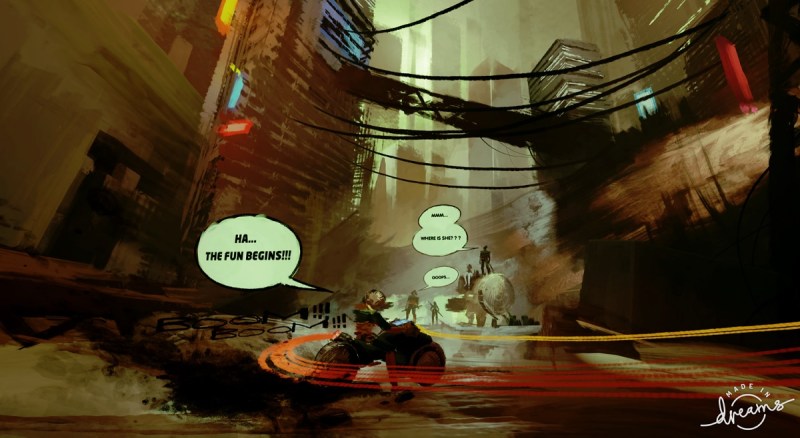
Above: Dreams features all kinds of cool art.
GamesBeat: Do you have a way of surfacing the most popular ones?
Heppe: We have the recommendation system. You can also sort by the most popular levels, the most played, or the most recently published, or by creator. That’s one of the things we’re working on improving as we go forward as well, to make sure we’re keeping it current with what the community is doing, so new creators are able to find their way into the top content.
Beech: Once you finish your dream surf–you may stay here for a couple of hours just diving through stuff. When you finish it gives you a list of all the things you played so you can go back and look at them individually, see if they’re remixable, perhaps put them in your own collection. Let’s do some creation.
Heppe: Everything you saw is all created in Dreams with the tools that everyone can access. John’s going to throw together a very quick thing made from scratch. The cool thing about Dreams, and one of the things we’re adding throughout early access, is that Dreams comes with a full slate of tutorials to teach you all the different areas of create. We have templates for different kinds of games. Maybe you’re interested in learning how to make a marble game like we just showed. We have something that allows you to do that.
We also have master classes, if you’ve gotten really in-depth and you want to hear someone like our art director share his tips and tricks. We have asset collections that all work together so people can use them. We give people a lot of jumping-off points to create if they don’t come with an idea already. John’s using the sculpt tool to make some grass. It’s like sculpting with digital clay. You can change your textures. He can easily stamp and clone things around the level to build out the world very quickly.
Beech: The cool thing is, if you don’t feel comfortable creating things from scratch, you can search really simply. In this case I want to find some rocks. You head up here and type in the keywords. I’ve found a rock. You stick that in your level and there it is. You can scale it and shape it to the size you want, and now you have a rock.
Heppe: Not everyone in our community is an asset maker or a content creator. We have people who are just creators. They take the best things and make them into collections for other people to use. We have people who’ve made collections like the one right here, nature assets, or ancient times assets. It’d be everything you need to make your fantasy game. People are really good at curating and showcasing the coolest stuff.
GamesBeat: Are you doing anything like Project Spark did, with a chain of ownership?
Beech: Yes, I should show you that. If there’s any item you find — let’s go look at your level, Princess Cowboy. You can search by dreamer and find your friends. You can follow individual creations. There’s a whole social network here as well. You can leave comments and reviews.
Heppe: This is my profile. When John goes there, he can see my creations. I’ve made this cool architecture space that you can walk around in. You can see how many people have played it and who’s remixed it. I left that comment to someone who made an asset for my level, because it was very cool. If you go to versions and release, you can see the different times I’ve uploaded it and what I’ve changed. You can go back to any one of those.
Then, under genealogy, you can see all these different things. I have all these plants in it that I took from other people in the dream-verse. You can go and visit those individual assets. You can see who’s used my stuff, who’s remixed it. If you go to full credits here, it tells you everyone who participated and everyone whose stuff I’ve used. This is like my game team. It’s very collaborative. We don’t expect everybody to just sit down and make a game. We want people to collaborate and help each other out. We’ve already seen it in the community. We have great music people, and then someone else will come in and help them with something. John’s had people make music tracks for his levels.
Beech: It’s so good. I’m not that musically inclined. I want to make all these special effects and gameplay mechanics. Then I got someone else in the community to make a set of songs for me, because I wanted some smooth jazz. They obliged in a really nice way. It was super.
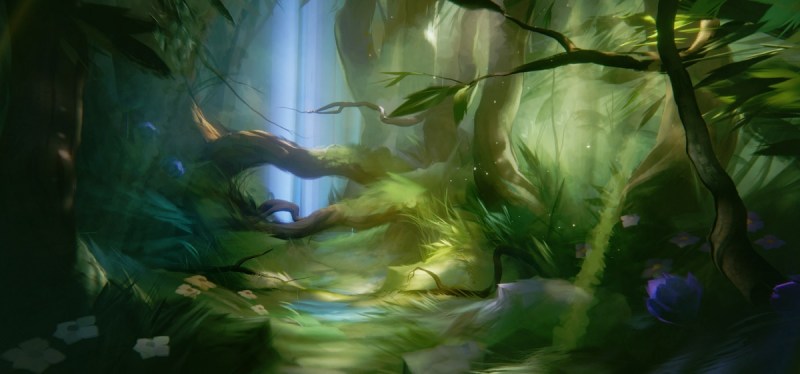
Above: Dreams has been in the works for more than five years.
GamesBeat: The assets you have, are there Media Molecule images and videos separated from the user-created assets?
Heppe: For each of the different areas in Dreams we have a curated collection of Media Molecule assets. We have more coming throughout early access. Everything will work well. A lot of them have gameplay built in, so that we can help people build those things quickly without having to make art or logic or anything themselves. We also have a full slate of sound effects and instruments. We have lots of ways for people to create without having to just do it all. And the community continues to make stuff like this. This is a community collection, not ours.
Beech: This is just made by — you can see the names. That’s “Lichmaster7.” You can see that I’ve got no inclination toward making a new sculpture. I can just throw a load of things together. It’s a fun way of making things. I find this really therapeutic. Let’s change the sky around a little bit.
Heppe: We have all these gadgets in the game. This is our section that’s all things for helping create gameplay and ambience. The cool thing is, everything you do in the game happens on screen. You’re never waiting for something to render. If you’re just learning the tools it’s easy to play around with these and see what it’s doing. In order to change the time of day, John just picks up the sun and puts it where he wants it to be. That’s helped me too, because is the first 3D creation tool I’ve ever used. Coming in with no experience, all of that visual feedback has helped me figure out how to do a lot of this stuff much quicker.
GamesBeat: Do you run into a size limit at some point?
Heppe: We have a thermometer in the game. We can turn it on quickly to see it. You can see John’s barely used any of it yet. Each of those three thermometers will go up depending on what’s eating it up, whether it’s graphics or gameplay. Once you fill the thermometer, that’s when it would start impacting framerate and that sort of thing.
If you’re doing this level and you want to make another big part for it, you could create a doorway to that next piece of content, and then the thermometer resets. You’re in a new create space. You can link together spaces and create an open world game. But the limits are pretty
solid. There are lots of tricks for optimizing content. We also have a tool where you can brush over what you’ve made and reduce the impact on the thermometers. It’s helpful if you’re trying to optimize your level. We try to make it as easy as possible.
This is our grade and effects gadget. John can play with the brightness, the contrast, the saturation. We have some fun ones. If he wants to turn the level 8-bit, he can just do that globally. We have a bunch of others. This is useful if you’re making cutscenes and camera shots and things, making it look like film. There are tons of options. In order to put a light in that hole there, John just puts a light in the level, and you can see where it’s shining. Then he has options to change the color or the global filter. Everything is meant to be easy.
One of the goals for Dreams is for it to be very performative. You never think of doing game development as performance, but Dreams allows you to. John and I do live create demos. Or not even demos. We do live game creation all the time now. Our team has been doing musical
performance with it as well. I’d love to see the community do that too. It’ll be fun to see what people end up doing. I can see people using it to prototype things.
GamesBeat: A bit like a Bob Ross show.
Heppe: Oh, yeah. Our art director totally does the Bob Ross streams. “If you go over here and use the soft blend–” [laughs] It’s a lot of fun. At any time, you can hop into play mode and test your levels to see if everything works together. You’re a character and you can run around.
Everything works like it should. That’s a community-made character, Frederick the Fox, and it’s been used everywhere. People have made buff versions of it and knight versions of it. It’s very cool.
Maybe you can show setting up a camera? We haven’t even gotten into the real gameplay tools yet. This is still scene-setting and creation. Just like with the light, you put in a camera and line it up to where you want the camera to look. If you’re creating a cutscene, it’s there. You can set up your shot the way you want to. It looks so good already.
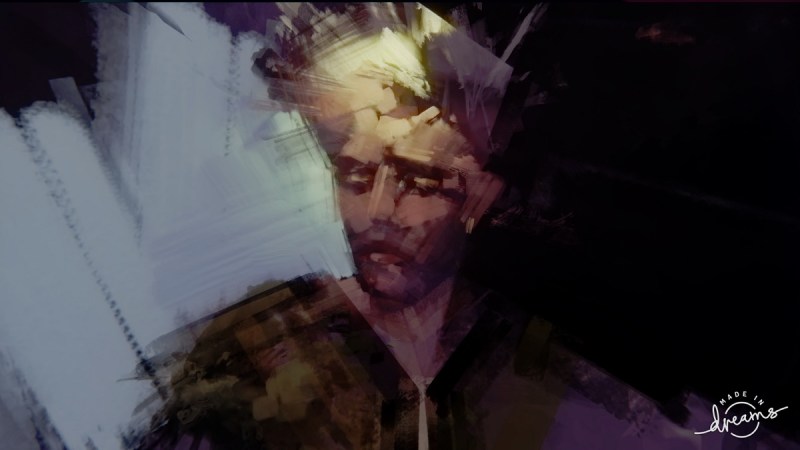
Above: You can make happy or creepy art in Dreams, as you wish.
Beech: I’ll put the snow back in, make some fresh show.
Heppe: He’s using the paint tool to make some snow. The paint tool is one of my favorites, because not only can you use this to paint in 3D space like a traditional artist would, but we also use it to make special effects and weather. John’s going to draw a line and add some animation effects that will make it look like snow.
Beech: I can just tweak this. Everything in the game has tweaks that you can wire logic into. In this case I’ll make this line I’ve just drawn into snowflakes. If I let time run, you can see them trickling down here like this. Then, if I adjust them enough, I can make them glow a bit so you can see them. Then I duplicate it around the camera so we get loads of them. We can increase the size and spread, change the jitter. After just a bit of playing around you can get some convincing snow in your level. Then we jump into play mode.
GamesBeat: How will people learn how to do that?
Heppe: We have tutorials for all the different areas, but for really specific stuff like that, some of the stuff we do for video content on the Media Molecule channels–we do streams each week. Sometimes we show community creations, or we’ll jam together and create together. Our community is also super helpful, showing people how to do things. Some of it is just play and figuring it out as you go. But we try to meet people where they go, sharing how to do stuff and teaching as much as possible. We have lots more on the way. We’re still working on more tutorials for specific things. We’re working on video content that will show people quick tips.
Beech: You can jump into edit mode at any point while you’re playing and change things from the player’s point of view. It’s good if you’re blocking out a level and you want to do something. Maybe I’ll make some platforming. I’ll add some stairs that circle up around like this. Then you can carry on playing at that point to test out your creation, see if it’s working. It’s a great way of integrating scenes. What’s amazing is, I can then tweak this character and adjust the jump height. Maybe this character can jump quite a bit higher. It’s totally cheating, but–the speed with which you can make gameplay in Dreams is very fast and very un-precious. You can do things without having to think about it too much.
This is one of the most coherent levels we’ve made yet. Usually we end up with a mashup of four animals or something like that in a disco. But this one’s taken a more serious approach. I’m quite into that. I think I’ll put a fence around the top. At any point I can just say, “I want a fence,” and build the fence.
Heppe: Every area in Dreams, whether it’s sculpture, painting, animation, sound, they all have easy, intermediate, and advanced bits. Everything we’re doing in this demo is pretty beginner-mode, taking objects from the dreamiverse and stamping them down. We’re just placing things like you would with a dollhouse. But on the advanced level, you can make everything from scratch. You can put as much time and effort into doing things as you want to. The goal is to make this so accessible that anybody who has an idea of what something should look like or be can go in there and do it.
Like I said, this is my first 3D creation platform. It’s been an incredibly journey. I know I work in games, but I’ve been able to work on game jam games and things that people are playing in Dreams now. I worked on the music or the characters. That’s a really cool feeling, coming from a job that has nothing to do with that in game development. It’s been liberating.
Let’s do some music. The sound tools are a good example of the easy, medium, hard part. This is a timeline. If you use video editing software, time moves from start to finish and this represents time in the level. We can put that camera on the timeline and build–I could put that there, and that’s how long that shot would last when we go into this scene. But we’ll leave it off for now and keep it over there. You can go forward and back with the edits you’ve done quickly, so if you feel like you messed something up, you just step back. It’s very simple.
We have these collections of assets, as I said, to help you build with assets, and the same is true for audio. In sound effects, John looked for some ambients. We have lots of sound effects. If you have a river, you can find the sounds of water and streams. These just continue to grow. They can also be made by the community. But on the music side, we have all these music clips. We have music tracks too if you want to use them.
I’ll show you what a professional music track looks like in Dreams. This was made by one of our audio people. It has a mastering channel where they’ve done the audio mastering, but it’s a pretty–
Beech: They made this in a game jam, actually. They made this for the Global Game Jam.

Above: Dreams are connected by doors.
Heppe: You can see all the different notes, all the different things that are playing in the track. These are all different instruments, and I can just mess with this. Maybe I didn’t like the sound of that, or I want there to be one more beat, and I can start to play and remix someone else’s track. But we’ll make one from scratch. It won’t be as complex, but it’s going to sound awesome.
GamesBeat: Can you set it up so someone can’t mess up what you’ve already made?
Beech: It’s up to you. You can publish things to be completely remixable, and then people can change them, but the original copy will still be there. They can’t go into your level unless you give them creative access. You might be working as a team with someone.
Heppe: If I go into drums–everything that’s in this collection is all meant to work together. They’re all quantized and they’re all in the same musical signature. Hypothetically, anything you choose here should sound pretty decent together. I play with this all the time by just choosing random things. I’ve never used this one before, so we’ll try this.
Beech: “Popsicle Breakbeat.” The names are always “Popsicle” [because] makes sense, because it’s cold.
Heppe: And then we’ll choose some bass. Let’s see if there’s a wintry-themed bass. Here’s one. Let’s see how it sounds together. I like it. We could keep adding to that, adding more clips. The nice thing about Dreams is that everything you learn to do–John was cloning stuff in the level. I can do that here as well. We can expand this timeline and I can clone these to my heart’s content. Everything you learn teaches you about something else, which has helped me figure out how to do everything in Dreams.
We also have this collection of instruments. We have everything — keyboards, bass, synth, drums. I like synth because I’m not super musical, so it’s easy for me to get in and — maybe Spooky Presence? Let’s try it. This is an instrument. All I’m doing to play it is using the keypad on the PS4 controller mapped to different notes on the scale. If I want a higher octave I tilt to the right, and if I want a lower octave I tilt to the left. I’m just playing. If we start a track, I can record.
These things that light up are effects pedals, effects fields. I can make my own or use existing ones. Some of the instruments come with them because it makes them sound cool. If we play back what I just played, you can see the notes going through the instrument, playing back what I just did in real time. Or if we hop into piano roll, you can see the notes I played on a scale. This is what I mean about how everything is easy, medium, or hard. If I wanted to dive in a bit more, I can edit on this and change my notes. I can shorten and lengthen them. I can make chords. I can do whatever I want to. Or if you’re really hardcore you can get into editing individual slices. It goes very deep.
Beech: It starts very simply, but it goes as deep as you want it. You can travel down further and further if you want to. We don’t want to force anyone to go deep, but it’s there if you want to.
Heppe: Even here, if I wanted that to be a bit louder, I could just up the volume here. We make this loop. You can chart to change everything like pitch and reverb. We have lots of options. You can start to learn more and more about making music. It’s super playful. You can choose chords, change what key you’re in–it’s such a rabbit hole. But it’s one of my favorite places to play around in Dreams. It’s super fun.
Beech: We’ll go into play mode and see what it looks like there. Frederick is on a mission now.
GamesBeat: If you wanted to learn something like mixing, can you do that?
Beech: That’s the nice thing about all different areas of Dreams. John will quickly show animation. That’s another one where — the simplest form of animating in Dreams is basically puppetry. You just move something with the controller, like John is doing right now, where he puts that gadget down. The next thing he touches, the game records it. John’s just made a platform, and all he’s done is lift that piece of rock up and down.
Beech: Now it’s rudimentary gameplay. We have a moving platform that I have to try to get onto and go up to the next bit.
Heppe: But you can go really deep. You can go into character animations and do keyframe animations. You can learn how to do a skill. There’s a lot of potential for education and people building their portfolios.
Beech: I’ll show a very small bit of logic combined.
Heppe: We have a totally visual logic system.
Beech: In this case I’ve put down a trigger, just an area. If something goes into this area, you can trigger something else. In this case I’ll use the keyframe that we mentioned earlier. When I place one down, I go into record mode, and whatever I do now will be recorded. In this case I’ll tell this rock to become movable. What will happen when I wire that up–the fox enters this area and this rock should hopefully fall down. We can attach a sound effect to it or some visual effects, but in this case we’ll keep it simple.
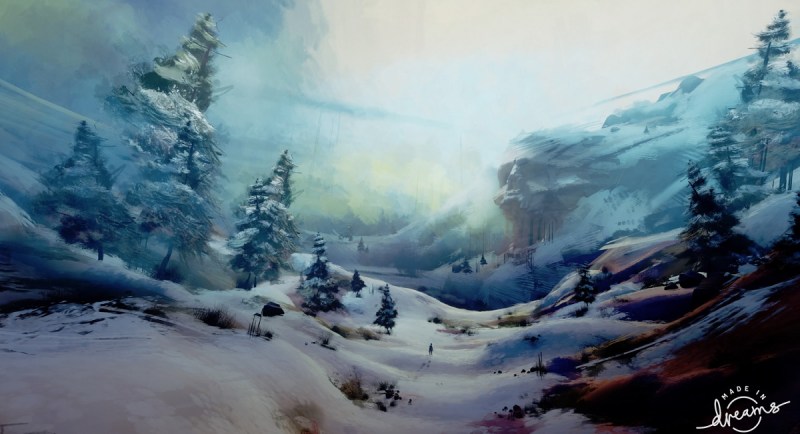
Above: Dreams has beautiful user-generated art.
GamesBeat: Have you gotten to a point where somebody’s said, “Hey, I created something cool. I want to publish this and sell it”?
Heppe: Outside of Dreams? Right now we allow people to publish inside Dreams. People can create and publish and other people can play it and remix it. That’s all available in Dreams.
Whether we allow people to do that outside of Dreams has been, actually, a big goal for the studio. It’s something we would love to do. But we need to figure out the best way to support that. Obviously if it’s published in the PlayStation store, we want it to be QA’d. We want trophies. There are all of these other elements. We’d love to do that kind of thing, but we don’t currently have a way to do it.
GamesBeat: What about a way of rewarding people? Can people get paid for this?
Heppe: It’s something we’ve thought about. We haven’t made any public announcements about any further monetization in Dreams, or that kind of system where people are getting tipped or getting paid for their content. We do want to encourage people to share. We’re a platform for amateur creation and hobbyist creators. I’m sure there will be people who are more professional in it. But these are all things we’re considering and thinking about.
The nice thing about early access is it allows us to develop the game alongside an active community. There are lots of things we can only learn from them, having the game be out. For us it’s a period of learning and thinking about what’s next.
GamesBeat: That’s a rare move, to do early access with a game like this.
Beech: It’s Sony’s first ever.
Heppe: Yeah, the first Sony game in early access. But Dreams is so unique that it requires a unique approach to so many different things. It’s one of the things that’s most challenging about it, but also one of the most rewarding. Sony has been great about letting us be a bit more experimental — being the first game in early access, being a creation game for everyone. We’re excited to see where it leads. If the stuff we’ve been seeing in two weeks is any indication, there’s a lot of potential.
GamesBeat: Do you see any kind of lesson in some of the things that haven’t lasted, like — Project Spark seemed like it was a good idea, but it didn’t stick around that long.
Heppe: What’s interesting about Dreams, and what’s so different about it — even compared to LittleBigPlanet — is that you can make things that look like your own style, your own art, your own thing. It really is a game development engine. Everything you made in LittleBigPlanet looks like LittleBigPlanet. Even if you make something that isn’t a 2D platformer, it looks like LittleBigPlanet. Dreams is made to let people’s imagination, their art style, their personality, their creativity shine. That’s one of the things that makes it unique.
Beech: The difference, certainly, between Dreams and Spark — the assets in there had to be made by the developer and brought in. Then it was about their community assembling to make unique experiences. Whereas in Dreams, they’re not reliant on us at Media Molecule to produce assets. They get to produce their own assets, their own music, their own sound effects.
Everything you see in Dreams is made in Dreams. There’s nothing that has to come in from outside. The community in Dreams can become self-perpetuating, because they’re not reliant on any outside source. That’s the lesson we learned from that. Give them the tools and they’ll
stay around.
Heppe: We’re in the early days. It’s been very promising. People have been doing things with the tools in the game that are just not what we expected. It’s fascinating. It’s been a great learning experience for us. Somebody made a game entirely with the text gadget in Dreams, and it’s brilliant. Seeing that kind of stuff is so inspiring. I can’t imagine, in six months, some of the stuff we’ll be seeing that we haven’t even thought of yet.
Beech: You can see how easy it is to put together an experience like this.
Heppe: John is setting its release as public and remixable, so now anyone who comes in–you saw the warning we skipped through. We give people an idea of what that means. That means anyone can go in there and play with what you made and make their own changes. Some people in our community are happy for that to be the case and some of them would rather keep it their own game, their own thing. We get both. We try to give people as many options as possible.
John’s in our tutorial section now. What I love about our tutorial team is they’ve done their best to make this fun, to make it funny, to make it not feel like work. I know people hear “tutorial” and think they’ll be so bored, but that’s not our goal at all. I’ve been amazed with what they’ve done.

Above: Dream’s building works because it makes sense.
GamesBeat: Have you seen teachers in classes start using this?
Heppe: We just had Girls Make Games come in to the studio, and the girls all made levels in Dreams. What was really cool, this is the first time Girls Make Games has been able to have music creation. This puts everything all in one package, so you don’t have to hop between programs. The girls were able to make music. I listened to all the tracks, and they were fabulous. It was really funny. They were all different. There were metal tracks and house tracks. It was so much fun.
Our outreach manager works with a bunch of educational groups. We’ve been talking to quite a few schools about doing things with Dreams. We have a lot of people even now — John was saying earlier, some of our community members have used it for class projects. The skills you’re learning and what you’re doing can be quite complex. It’s really cool to see people using it for education. That’s an important thing for us.
Beech: You can see here on the profile, it’s given me a persona. It knows we like to play, so it’s given us a play persona. That changes over time as you change your outlook on Dreams. We can see what our current passion is. Our current passion here is art. Play is still fairly high.
GamesBeat: It’s like a scoreboard.
Heppe: You can add scoreboards to levels, too. Our community has been squaring off in a whole bunch of competitive games, which has been pretty funny to see. There are some really silly games that have very competitive communities around them now.
People have done some things that are so clever. One of my favorite games, you play as a sort of bird that’s a realtor. Not only do you have to fight all the monsters in the basement, but you have to mark everything that needs to be fixed by the landlord. It’s very cute.
Beech: This is one of the first scoreboards we saw published. You walk up and step on a rake and it hits you in the face. It lasts forever. There’s no limit to how much you can do it. And then you go here when you’re done and walk through the door. It’s fun to see the scoreboard. I’ve just done five. You go through the exit and it bashes you away. But when you look at the scoreboard on it, you can see that someone stayed here and walked on that rake 3,005 times. [Laughs] Unbelievable.
Heppe: People are amazing. It’s been such a journey, getting the chance to look in people’s heads and see all the awesome creative things they think of. It’s been fun.
Beech: And there’s nowhere else you’re going to find this. Where else will you find someone who’s made a curated museum of their art pieces?
Heppe: You can walk through and have a narrative experience. Or just hit yourself in the head with a rake 100 times. Or 3,005 times.
Beech: Dreams will be the only place you can come and find these kinds of interactive experiences. You just can’t get this anywhere else.
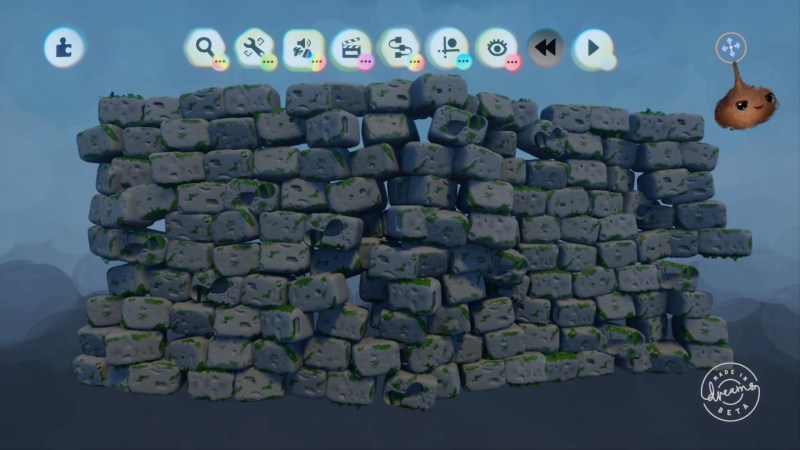
Above: A wall may not seem all that creative, but Dreams gives you the tools to take it in many directions.
GamesBeat: How long do you think early access will go for?
Heppe: We’re not quite sure. Our goal is not to spend a ton of time in early access. We want to get Dreams out. But it’s allowing us to polish some things like the social systems and add a bunch more things that we want for the people who aren’t our core creative community. The tools are really polished. Our community gives us feedback on very specific things that they’d like to see. But we’re happy with where these are at.
We want to make sure that when we launch to the wider community, we have the full breadth of tutorials, of templates, of collections of assets and things for people to use to get started, so they can have the best possible experience, especially if they’re going to be new to creation.
There’s a huge play experience. You can go in and spend hours and hours playing right now. We do that all the time. But we would love to bring some of those people into creation, because the goal of this is to make it accessible, make it easy for people to do. Part of early access, for us, is working on that.
We have a list of things we want to add and support that’s a million miles long. Online multiplayer is one of those. We’ll get to all of those things eventually. Maybe not necessarily during early access, but in the lifetime of Dreams, in the updates we do when the game is in full release. We just want to make sure that when we put this out there to everyone, it’s a great experience for more than just our people who are already, “Let’s create!”
GamesBeat: Something like Twitch has, what, 3 million creators and 100 million viewers?
Heppe: Exactly. It’s like YouTube. Most people who use YouTube aren’t content creators. God, though, the Twitch applications for this — it’s so cool, in that performative aspect, to be able to make a game with your community. You can challenge them to make something and then you can use that in a game, or you can use their choices to inform what you create. You can make something together. That kind of stuff–that’s just scratching the surface of what you can do. I think it’ll be really fun to see the the community that develops around teaching and sharing and creating with other people. That really excites me.
We’ll also be adding more Media Molecule playable content. We have this thing called the MM Arcade. We’ve been putting out games made by individuals at the studio, or sometimes larger groups at the studio. We let the community remix some of them so they can see how we build things, how we make logic. John made this. This is an example of one of those things. It has full AI. It’s super relaxing.
GamesBeat: Did you think of doing your own single-player story?
Heppe: We’re doing one, yes. We’re working on a slightly longer piece than these little arcade games that tells more of a narrative, so we can show the community more about cutscenes and what a fully realized game looks like. That’s one of the things we’re targeting in the full release. But even between now and then, we can’t stop making games in Dreams. We keep adding more stuff. It’s been a lot of fun.
